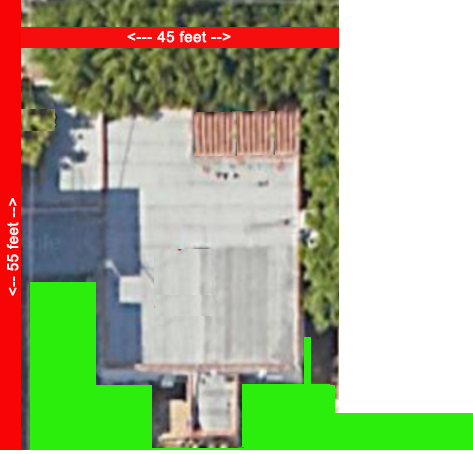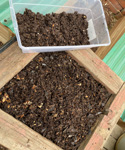
Adventures in an Urban Kitchen Garden
| Seed Starter Temps | Square Foot Layouts | Starting Seeds Indoors | Starting Seeds Outdoors |
| Seed Starting Trays | Herb Square | Vegetable Square | Shallow Roots |
| Winter Vegetables | Planting Guide | Worm Bin Info |
I basically use the square-foot method of growing, except I don't really
use a ruler. You have to when you have a yard as massive as mine is.
My lot is a whopping almost 2500 square feet. Within that footage
exists a two-bedroom house and a garage. I am surrounded by large,
hideous condos and three-story townhouses. Consequently, my garden
allotment is small, and non-contiguous. This is an overview of the house:

The area blocked out in green is the most generous depiction of
the grow zone. Naturally it's not all usable but a lot of it has been
portioned out for production. Here's how it breaks down:

Seating and the bbqs are next to Flower Island.
Square Foot Gardening Color Guide:
| COLOR | Plants per square foot in raised beds | Notes |
|---|---|---|
RED |
16 |
Carrots, garlic, leeks, |
YELLOW |
9 |
Lettuce, spinach |
BLUE |
4 |
Corn, onions, shallots, |
ORANGE |
1 |
|
WHITE |
4 square feet |
Melons & squash, etc. |
PINK |
Little Pots |
Most flowers: Most herbs: basil, bee balm, borage, cardoon, chives, chervil, cilantro, dill, fennel, lavender, mint, oregano, parsley, sage, tarragon and thyme although some herbs will double as border plantings. |
GREEN |
Big Pots |
Big plants; artichokes, peppers, tomatillos, tomatoes, etc. |
GRAY |
Borders |
Walkways, around plants. Marigolds, nastiurtums, |
Good Advice from Utah State University
LIQUID NITROGEN FERTILIZERS

Can be applied as a foliar, planter placement, topdress, sidedress,
and fertigation. It can also be mixed with other nutrients and crop protection
products, so you can apply at nearly any time (that is is warranted...).
Urea may be the fertilizer of choice when only nitrogen is needed in a soil fertility program.
For a cheap, homemade nitrogen fertilizer, add two cups of used
coffee grounds to 5 gallons of water. Leave overnight,
strain the
liquid into a bottle and add to the soil or spray onto your plant's leaves.
EARTHWORM CASTINGS

My first haul from my wormhouse yielded about 5 or 6 lbs !
Worm castings are rich in micronutrients, containing iron, sulfur,
magnesium, zinc, copper and calcium. They also provide macronutrients
and have a nitrogen, phosphorus and potassium (NPK) ratio of 1-0-0 to 5-5-3.
The castings are rich in water-soluble plant nutrients, and contain more than
50% more humus than what is normally found in topsoil. Worm Castings
are packed with minerals that are essential for plant growth, such
as concentrated nitrates, phosphorus, magnesium, potassium, and calcium.
Worm castings contain five times more nitrogen, seven times
more phosphorus, and 11 times more potassium than ordinary soil.
Unlike chemical fertilizers, worm castings won't harm your plants
regardless of how much you add.
DIY Bone Meal Fertilizer:
Save and clean the animal bones from a few meals.
Line a baking tray with cleaned bones, then bake at 284 degrees or higher for around three hours.
Grind the baked bones in a mortar and pestle or stone grinder to create a fine powder.
Set a large pot of water to simmer over medium heat and add the powder.
Wood Ash Fertilizer:
Wood ash is full of calcium and also loaded with other nutrients including
potassium, phosphorus, and magnesium.
For the nitrogen (N), the common fertilizer is blood meal.
For the phosphorous (P), the common fertilizer is bone meal or fish meal.
For potassium (K), the common fertilizer is potash.
Once you have the ingredients, buy a kitchen scale and a Rapitest test kit and off you go.
The test kit comes with a ton of information about adjusting NPK values and PH and a
comprehensive guide that covers ideal NPK values and PH for all kinds of varietals.
It’s a fun spring project.
If you Google “How to add ________ quickly” for each of the ingredients,
you’ll find a ton of suggestions for adding nitrogen, phosphorous and potassium without using fertilizer.
Messing around with a test kit and the three basic fertilizers is a great way to get to know
your garden and to establish some baseline measurements to work from
(after a couple years of testing I now know that my azaleas and rhodos are
always ready for some Evergro 10-8-12 this time of year, my shrubs are always
ready for some Evergro 18-4-8 and everything is probably ready for a light dusting of lime
before the fertilizing begins). Potassium nitrate and calcium nitrate are cheap and
highly available for plants to absorb. Potassium phosphate is great for the P and the K.
Bone meal can take a long time to break down and get absorbed, so you can make a
much more fast acting and cheaper fertilizer using non organic.
The difference in organic versus non is purely aesthetic.
Perhaps the easiest way to adjust the NPK ratios would be to start
with something like Miracle-Gro and add say potassium nitrate to increase
ratio of potassium to phosphorous or potassium dihydrogen phosphate
to increase the ratio of phosphorous to nitrogen. Using something like
Miracle-Gro would be convenient since it already contains calcium and
magnesium as well as all the required trace elements.
The basic compounds to blend a nutrient mix from are:
potassium dihydrogen phosphate
calcium ammonium nitrate
magnesium nitrate
ferrous sulfate
zinc sulfate
boric acid
manganese sulfate
sodium molybdate
cobalt nitrate
sulfuric acid
potassium nitrate
(Potassium nitrate has an NPK 0f 13-0-45 so pure
potassium nitrate has a high potassium ratio.
Actually, when you are formulating your own
nutrient mixes, getting a high nitrogen ratio is the
hardest because
that requires ammonium nitrate
which is hard to get assuming that you aren't
going to use urea.)
Utilize organic fertilizers like worm castings, blood meal, fish meal,
or bat guano for nitrogen; bone meal or rock dust for phosphorus;
wood ash or kelp meal for potassium; and dolomite lime for calcium
or magnesium.
Alfalfa Meal
Canola Meal
Bone Meal (or rock phosphate)
Seaweed
![]()